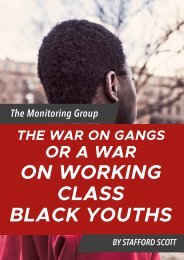Coming of Age : 1976 and the Road to Anti-Racism
Coming of Age : 1976 and the Road to Anti-Racism by Jagdish Patel and Suresh Grover
Coming of Age : 1976 and the Road to Anti-Racism
by Jagdish Patel and Suresh Grover
Create successful ePaper yourself
Turn your PDF publications into a flip-book with our unique Google optimized e-Paper software.
‘Britishers<br />
first’ was <strong>the</strong><br />
overriding<br />
sentiment<br />
during<br />
disorder in <strong>the</strong><br />
ports<br />
Post-war mass protest <strong>and</strong> riot <strong>of</strong>ten involved organized ex-service<br />
groups out <strong>to</strong> draw attention <strong>to</strong> perceived injustice in <strong>the</strong><br />
treatment <strong>of</strong> returning troops <strong>and</strong> <strong>the</strong>ir dependents. Many former<br />
soldiers <strong>and</strong> sailors were left disillusioned by <strong>the</strong>ir lot on demobilisation.<br />
The National Federation <strong>of</strong> Discharged <strong>and</strong> Demobilised<br />
Sailors <strong>and</strong> Soldiers staged a range <strong>of</strong> co-ordinated campaigns<br />
<strong>and</strong> demonstrations throughout <strong>the</strong> country in 1919 <strong>and</strong> 1920. Their<br />
‘monster’ demonstration outside parliament in May 1919 descended<br />
in<strong>to</strong> violence <strong>and</strong> was broken up by a police ba<strong>to</strong>n charge. 4 In<br />
Lu<strong>to</strong>n in July 1919, rioters, including many ex-combatants, burned<br />
down <strong>the</strong> <strong>to</strong>wn hall. 5 There were also riots involving recently demobilised<br />
troops in London in March <strong>and</strong> in Edinburgh in July 1919. 6<br />
The prominence <strong>of</strong> service <strong>and</strong> ex-service personnel in social unrest,<br />
mass protest <strong>and</strong> rioting across Britain in <strong>the</strong> twelve months after<br />
<strong>the</strong> end <strong>of</strong> <strong>the</strong> First World War was a sign <strong>of</strong> <strong>the</strong> times. It is hardly<br />
surprising that individuals in uniform or sporting service ribbons would<br />
be visible in ga<strong>the</strong>rings <strong>of</strong> people in <strong>the</strong> weeks <strong>and</strong> months after <strong>the</strong><br />
Armistice given that Britain’s combined armed forces <strong>to</strong>talled 6.6<br />
million at war’s end. The violent participation <strong>of</strong> troops <strong>and</strong> former<br />
service personnel in <strong>the</strong> seaport riots was frequently highlighted in<br />
contemporary press reports.7 However, recent combatants were not<br />
<strong>the</strong> prime movers in <strong>the</strong> port rioting. The riots in Britain’s seaports<br />
mainly involved white local civilians, some <strong>of</strong> <strong>the</strong>m merchant sailors.<br />
The myth that military service had brutalized those who served<br />
in <strong>the</strong> First World War leading <strong>to</strong> post war rioting <strong>and</strong> mass protest<br />
was used by contemporaries <strong>and</strong> later writers <strong>to</strong> account for<br />
<strong>the</strong> violence <strong>of</strong> this period. There was a widespread belief that <strong>the</strong><br />
trauma <strong>of</strong> war led <strong>to</strong> uncontrolled aggressive tendencies. It was a<br />
truism that innocence had been irretrievably lost through wartime experience.<br />
This assumption follows <strong>the</strong> so-called ‘brutalization’ <strong>the</strong>ory<br />
in which battle-hardened, war- weary men <strong>and</strong> women brought<br />
a tendency <strong>to</strong> violence in<strong>to</strong> <strong>the</strong> domestic sphere. The work <strong>of</strong> Joanna<br />
Bourke has convincingly refuted this <strong>the</strong>ory by examining <strong>the</strong><br />
impact <strong>of</strong> war on <strong>the</strong> psyche <strong>of</strong> ex-combatants. Bourke suggested<br />
that contrary <strong>to</strong> promoting violent tendencies in a domestic setting,<br />
<strong>the</strong> leading desire among ex-combatants was for a return<br />
<strong>to</strong> domesticity <strong>and</strong> an urge <strong>to</strong> forget <strong>the</strong>ir recent experiences. 8<br />
<strong>Coming</strong> <strong>of</strong> <strong>Age</strong> | 21<br />
<strong>Coming</strong> <strong>of</strong> <strong>Age</strong> Final version 16.10.indd 21 17/10/2017 12:06







